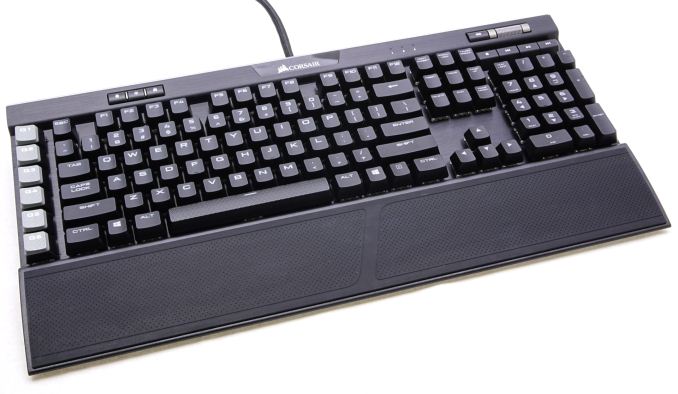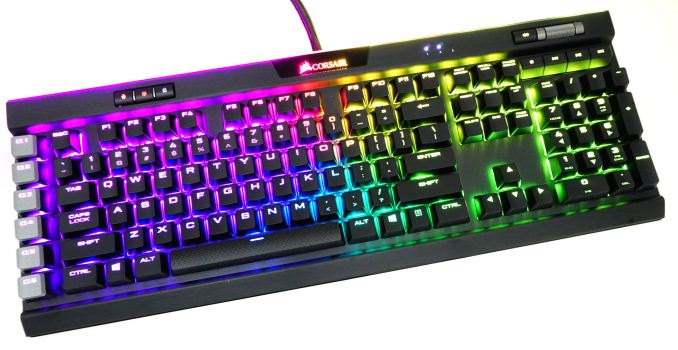The Corsair Gaming K95 RGB Platinum Mechanical Keyboard Review
by E. Fylladitakis on March 7, 2017 8:00 AM EST- Posted in
- Peripherals
- Corsair
- Cherry MX
- Mechanical Keyboards
- RGB
Conclusion
The Corsair Gaming K95 RGB Platinum mechanical keyboard truly is a special case. It is as if a designer woke up one day, gathered all of the feedback and criticism that Corsair had received for their previous models, and used it to create the a keyboard regardless of the cost. It clearly is a product trying to bridge the gap between the bulky K95 models with the many extra programmable keys and the common K70 models that are lacking them completely. We do not think that the new K95 RGB Platinum relates to the previous K95 models much; it actually is bewildering why Corsair chose to name it “K95” and did not give it a brand new model number. The K95 RGB Platinum would probably be more accurate described as an upgraded version of the K70 RGB, with extra macro keys and profile switching buttons.
In terms of quality and aesthetics, the new K95 RGB Platinum is just as elegant and robust as all of the previous K70/K95 series models. There is a reason why Corsair’s mechanical keyboards are globally renowned and highly popular. The aluminum body is very rigid and classy, while the manufacturing process is impeccable. Corsair improved aesthetics and lighting effects even further by illuminating their logo and the top edge of the keyboard. We also found the wrist rest to be very comfortable and versatile. Although it does not seem like much at first, the capability to switch from a comfortable surface for long-term typing to a textured surface for a good grip while gaming is very practical and comfortable. The rubbery surface of the wrist rest does get dirty relatively easily, especially the textured side, but it can be removed and cleaned with ease.
Our only real concern lies with the ABS keycaps, as they tend to deteriorate quickly. Very few manufacturers use other types of keycaps due to their significant cost, but we would have liked to see better keycaps on a keyboard with such a price tag and especially on a model that has a distinctive bottom row of keys, as replacements will be hard to come by. There are a few manufacturers that do offer high quality aftermarket keycaps for this layout, but these do not come cheap at all.
The designer did not stop on the hardware but is trying to address all criticism on the software side as well. Corsair used to be very proud of their Corsair Utility Engine (CUE) software, as it was one of the most advanced and versatile software packages for gaming mechanical keyboards. Its endless options and capabilities however could be overwhelming even for advanced users. Instead of working on the previous software package, Corsair did a complete overhaul of it, making it much cleaner and simpler to use by everyday users. For experts, all of the advanced options are still there, and the new interface also is much more straightforward with the programming of advanced actions and lighting effects. The new CUE also offers very useful new features, such as the online search of profiles and effects that prevents users having to browse forums and posts to find what they are looking for.
It is very difficult to find a real flaw about the new K95 RGB Platinum as a device. We cannot ask for a feature that it does not already have and its programming capabilities are virtually endless. It would be no exaggeration to claim that the K95 RGB Platinum may be the prime candidate for the title of the best mechanical gaming keyboard at this point of time. The only true competition of the K95 RGB Platinum is its own retail price. At $200, the K95 RGB Platinum is one of the most expensive mechanical keyboards at this point of time as well. If one can look past the price tag, the K95 RGB Platinum is one of the highest quality and most versatile mechanical keyboards available today.












37 Comments
View All Comments
zeeBomb - Tuesday, March 7, 2017 - link
This is a keyboard I'll probably never be able to own...qqlyeoh - Thursday, March 9, 2017 - link
What's the min/avg/max latency/input lag in milliseconds?If any of you are about to respond by mentioning the USB polling rate or similar it proves you don't know what you're talking about on this subject.
Because saying the USB polling rate is high and thus the input lag has to be low is like saying monitors with a high refresh rate will always have low input lag. And that's not true: https://displaylag.com/display-database/
Sarchasm - Friday, March 10, 2017 - link
That's an inaccurate comparison, and your instinct to compare it to monitors by posting a generic link rather than simply explain the need for response time information points to you not really understanding what it means either. Polling rates can help significantly (you're far more likely to register an input within the same frame with a 1ms polling rate vs. 10ms), but there are other considerations to that (such as whether the peripheral's controller keeps the polling window open, or simply polls at intervals).This is all functionally irrelevant though. Anyone asking this question seriously is looking for a reason to blame their equipment for their performance, when the margin of error is far more likely to be their own lack of response time and in-game skill. It's essentially a null factor - even in LAN play.
lyeoh - Monday, March 13, 2017 - link
1) Yes polling is important HOWEVER we're talking about gaming keyboards (as per the article) so the polling should already be at the max (1000Hz). If a USB keyboard is polling at low rates it's effectively not a gaming keyboard, or something is wrong (OS etc).2) There really are significant differences in keyboard latencies: wwwXblackboxtoolkitXcom / responsedevices.html
wwwXpstnetXcom /eprimedevice.cfm (broken links due to anandtech spam filter)
So far I have not seen any independent measurements proving that gaming keyboards are all practically the same with respect to latency, so are we supposed to take it by faith?
3) Even if you can't get the absolute numbers you can get relative numbers by comparing each keyboard with the same mouse- e.g. use the same mechanical setup to press the spacebar on the keyboard AND the mouse button at the "same" time. See: pastebinXcom/cckQWRwP
You can record the sound of the presses at 48KHz and view the recording to adjust things so that the clicks are truly close to the same time.
Then after doing a number of measurements you can swap the keyboard with other keyboards and compare the results. For example, I have a logitech PS/2 keyboard that is really slow (50ms slower than my mouse!), and I had a Kalashnikov AK990i keyboard that was faster than the Logitech BUT still slower than my a4tech X7 G800V (which has stuck key issues).
4) You claim it's a null factor "even in LAN play" and yet the evidence is against you.
Even 30ms is significant in the twitch gaming world. If everyone has ping times of >500ms then 30ms is not significant. But in LAN play it's like someone playing on the LAN with a ping of 2ms against a someone with a ping of 32ms.
Where are the benchmarks proving the latency differences for these gaming keyboards are insignificant? Thus my original question.
5) Last but not least your claim that I'm trying to blame my equipment for my performance is impolite and not a valid nor proper argument. If you choose to argue at this level you have little to contribute to a proper technical discussion.
Irishgamer01 - Thursday, April 6, 2017 - link
NICE RGB, BUT TRUELY AWFUL AS A KEYBOARD.CONSIDERING THE COST. AVOID.
OBVIOUSLY I OWN ONE.
Glenwing - Thursday, December 28, 2017 - link
Typo in the second sentence:"and used it to create the a keyboard regardless of the cost."
Glenwing - Thursday, December 28, 2017 - link
Second sentence of the conclusion I mean